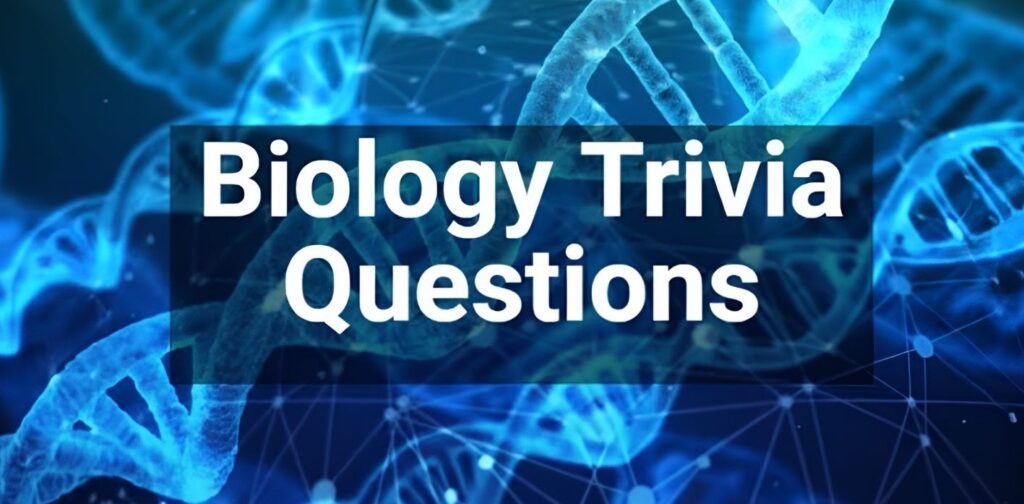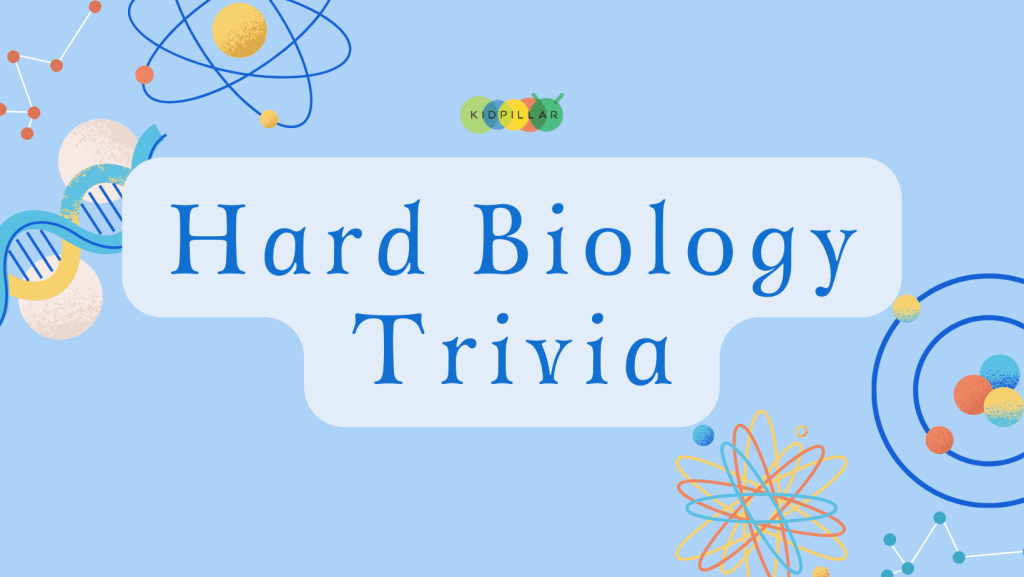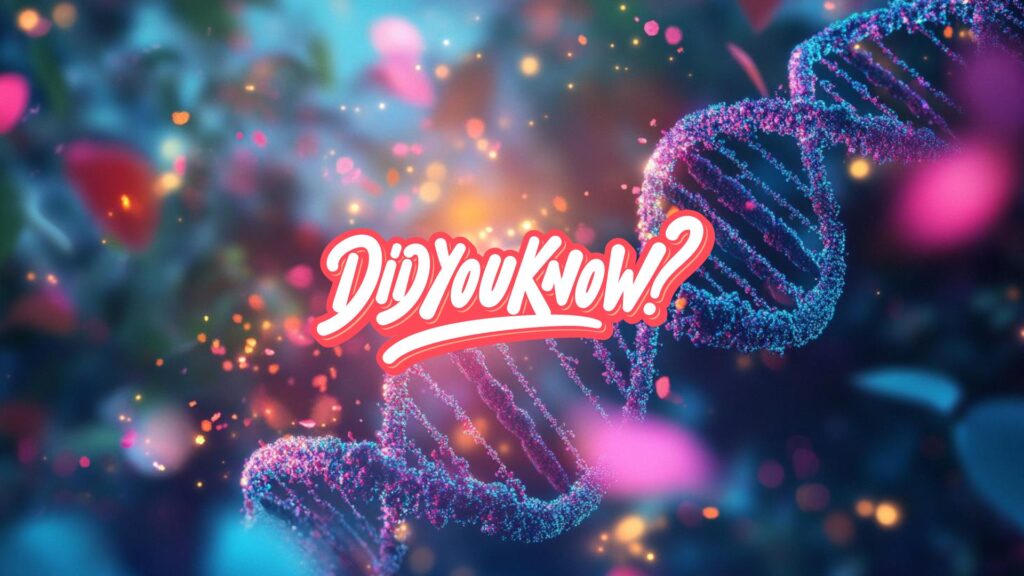Biology is a vast and interesting field that has always amazed us. From tiny cells to complex ecosystems, there’s always something new to learn.
If you’re a science lover looking to expand your knowledge or simply enjoy fun facts, you’ve come to the right place.
I’ve compiled a list of over 227+ biology trivia facts that will intrigue and educate readers of all ages. These tidbits cover everything from genetics to ecology and evolution to human biology.
In this article, you’ll find interesting information about the living world. Get ready to explore the wonders of biology, test your knowledge, and maybe even impress your friends with some surprising facts.
Let’s dive into the incredible world of life sciences!
List of Biology Trivia Topics to Explore

-
Q: What is the basic unit of life?
A: The cell -
Q: Which molecule carries genetic instructions in living organisms?
A: DNA (Deoxyribonucleic acid) -
Q: What process do plants use to convert sunlight into energy?
A: Photosynthesis -
Q: What’s the term for the study of the interactions between organisms and their environment?
A: Ecology -
Q: Which scientist is known as the “Father of Biology”?
A: Aristotle -
Q: What’s the name of the process by which cells divide to form two identical daughter cells?
A: Mitosis -
Q: What’s the main difference between prokaryotic and eukaryotic cells?
A: Eukaryotic cells have a nucleus, while prokaryotic cells don’t -
Q: What’s the term for a group of organisms of the same species living in the same area?
A: Population -
Q: Which organelle is known as the “powerhouse” of the cell?
A: Mitochondria -
Q: What’s the name of the process by which organisms maintain a stable internal environment?
A: Homeostasis -
Q: What’s the largest known virus?
A: Mimivirus -
Q: What’s the smallest known bacteria?
A: Mycoplasma genitalium -
Q: What’s the name of the theory that explains how species change over time?
A: Evolution -
Q: What’s the term for the functional unit of heredity?
A: Gene -
Q: What’s the name of the process by which organisms produce offspring?
A: Reproduction -
Q: What’s the term for organisms that can’t make their own food?
A: Heterotrophs -
Q: What’s the name of the fluid inside cells?
A: Cytoplasm -
Q: What’s the term for the movement of molecules from an area of high concentration to an area of low concentration?
A: Diffusion -
Q: How many bones are in the adult human body?
A: 206 -
Q: What’s the largest organ in the human body?
A: The skin -
Q: Which blood type is known as the universal donor?
A: O negative -
Q: How many chambers are there in the human heart?
A: Four (two atria and two ventricles) -
Q: What’s the name of the tiny air sacs in the lungs where gas exchange occurs?
A: Alveoli -
Q: Which gland in the human body is often called the “master gland”?
A: The pituitary gland -
Q: What’s the hardest substance in the human body?
A: Tooth enamel -
Q: How many pairs of ribs are there in the human body?
A: 12 pairs -
Q: What’s the name of the longest bone in the human body?
A: The femur (thigh bone) -
Q: Which part of the brain is responsible for balance and coordination?
A: The cerebellum -
Q: What’s the name of the pigment that gives skin and hair its color?
A: Melanin -
Q: How many taste buds does the average human tongue have?
A: About 10,000 -
Q: What’s the only organ in the human body that can regenerate itself?
A: The liver -
Q: What’s the name of the tube that connects the throat to the stomach?
A: The esophagus -
Q: Which blood cells are responsible for clotting?
A: Platelets -
Q: What’s the name of the largest artery in the human body?
A: The aorta -
Q: How many pairs of cranial nerves are there in the human body?
A: 12 pairs -
Q: What’s the scientific name for the voice box?
A: The larynx -
Q: What’s the process by which plants release water vapor into the atmosphere?
A: Transpiration -
Q: Which plant hormone is responsible for fruit ripening?
A: Ethylene -
Q: What’s the name of the tissue in plants that transports water and nutrients?
A: Vascular tissue -
Q: Which part of the plant typically absorbs water and nutrients from the soil?
A: The roots -
Q: What’s the name of the green pigment in plants that’s essential for photosynthesis?
A: Chlorophyll -
Q: Which plant is known as the “corpse flower” due to its foul smell?
A: Rafflesia arnoldii -
Q: What’s the term for plants that complete their life cycle in one growing season?
A: Annuals -
Q: Which plant hormone promotes cell elongation and stem growth?
A: Auxin -
Q: What’s the name of the female reproductive part of a flower?
A: The pistil -
Q: Which tree is known as the tallest on Earth?
A: The coast redwood (Sequoia sempervirens) -
Q: What’s the process by which plants bend towards light?
A: Phototropism -
Q: Which plant is known as the fastest-growing woody plant?
A: Bamboo -
Q: What’s the name of the tissue in plants that provides support and structure?
A: Xylem -
Q: Which plant group doesn’t produce flowers or seeds?
A: Ferns -
Q: What’s the term for plants that grow in water?
A: Aquatic plants -
Q: Which plant hormone promotes fruit development and delays leaf senescence?
A: Cytokinin -
Q: What’s the name of the protective outer layer of a tree trunk?
A: Bark -
Q: Which plant is known for its ability to close its leaves when touched?
A: The sensitive plant (Mimosa pudica) -
Q: Which animal has the longest lifespan?
A: The Greenland shark (estimated up to 500 years) -
Q: What’s the smallest known mammal?
A: The bumblebee bat (Craseonycteris thonglongyai) -
Q: Which animal has the largest brain relative to its body size?
A: The shrew -
Q: What’s the only mammal that can’t jump?
A: The elephant -
Q: Which animal has the highest blood pressure?
A: The giraffe -
Q: What’s the fastest land animal?
A: The cheetah -
Q: Which animal has the longest migration route?
A: The Arctic tern -
Q: What’s the only mammal capable of true flight?
A: Bats -
Q: Which animal has the most powerful bite force?
A: The hippopotamus -
Q: What’s the largest living bird by wingspan?
A: The wandering albatross -
Q: Which animal never sleeps during its entire lifetime?
A: The bullfrog -
Q: What’s the only known mammal that can’t feel pain?
A: The naked mole rat -
Q: Which animal has the largest eyes in the animal kingdom?
A: The colossal squid -
Q: What’s the only animal that can’t walk backwards?
A: The kangaroo -
Q: Which animal has the longest gestation period?
A: The African elephant (up to 22 months) -
Q: What’s the only mammal that lays eggs?
A: The platypus (and echidnas) -
Q: Which animal has the most teeth?
A: The giant armadillo (up to 100 teeth) -
Q: What’s the only animal that can’t stick out its tongue?
A: The crocodile -
Q: What’s the smallest known living organism?
A: Nanobes (controversial) or Mycoplasma genitalium (widely accepted) -
Q: Which microorganism is responsible for fermentation in bread making?
A: Yeast (usually Saccharomyces cerevisiae) -
Q: What’s the name of the process by which bacteria exchange genetic material?
A: Conjugation -
Q: Which type of microorganism is responsible for causing malaria?
A: Protozoa (specifically Plasmodium) -
Q: What’s the term for microorganisms that can survive in extreme environments?
A: Extremophiles -
Q: Which bacteria is responsible for nitrogen fixation in legume root nodules?
A: Rhizobium -
Q: What’s the name of the protective coating some bacteria form to survive harsh conditions?
A: Endospore -
Q: Which microorganism is used in the production of insulin for diabetics?
A: Escherichia coli (E. coli) -
Q: What’s the term for organisms that can live with or without oxygen?
A: Facultative anaerobes -
Q: Which microorganism is used in the production of vinegar?
A: Acetobacter -
Q: What’s the name of the process by which some bacteria produce light?
A: Bioluminescence -
Q: Which type of microorganism is neither alive nor dead?
A: Viruses -
Q: What’s the term for the symbiotic relationship between fungi and algae?
A: Lichen -
Q: Which microorganism is responsible for the fermentation in yogurt production?
A: Lactobacillus bulgaricus and Streptococcus thermophilus -
Q: What’s the name of the process by which some bacteria move using a whip-like structure?
A: Flagellar motion -
Q: Which microorganism is used in the production of blue cheese?
A: Penicillium roqueforti -
Q: What’s the term for microorganisms that live in the digestive tract?
A: Gut microbiota -
Q: Which microorganism is responsible for causing botulism?
A: Clostridium botulinum -
Q: How many base pairs are in the human genome?
A: Approximately 3 billion -
Q: What’s the name of the process by which DNA makes a copy of itself?
A: Replication -
Q: Which scientist discovered the double helix structure of DNA?
A: James Watson and Francis Crick (with contributions from Rosalind Franklin) -
Q: What’s the term for a variation in the DNA sequence?
A: Mutation -
Q: How many chromosomes do humans have?
A: 23 pairs (46 in total) -
Q: What’s the name of the process by which DNA is transcribed into RNA?
A: Transcription -
Q: Which genetic disorder is caused by an extra copy of chromosome 21?
A: Down syndrome -
Q: What’s the term for the complete set of genes in an organism?
A: Genome -
Q: Which molecule carries genetic information from DNA to the ribosome?
A: mRNA (messenger RNA) -
Q: What’s the name of the process by which RNA is translated into proteins?
A: Translation -
Q: Which genetic disorder is characterized by the inability to produce melanin?
A: Albinism -
Q: What’s the term for a gene that masks the expression of another gene?
A: Dominant gene -
Q: Which scientist is known for his work on inheritance and is considered the father of genetics?
A: Gregor Mendel -
Q: What’s the name of the technique used to make multiple copies of DNA?
A: Polymerase Chain Reaction (PCR) -
Q: Which genetic disorder is caused by a mutation in the CFTR gene?
A: Cystic Fibrosis -
Q: What’s the term for the physical expression of genes?
A: Phenotype -
Q: Which type of RNA helps transport amino acids to the ribosome?
A: tRNA (transfer RNA) -
Q: What’s the name of the process by which genes are switched on or off?
A: Gene regulation -
Q: What’s the term for the variety of life in a particular habitat or ecosystem?
A: Biodiversity -
Q: Which gas is most responsible for the greenhouse effect?
A: Carbon dioxide (CO2) -
Q: What’s the name of the process by which nutrients are recycled through an ecosystem?
A: Nutrient cycling -
Q: Which layer of the atmosphere contains the ozone layer?
A: Stratosphere -
Q: What’s the term for species that are at risk of becoming extinct?
A: Endangered species -
Q: Which type of forest is known as the “lungs of the Earth”?
A: The Amazon rainforest -
Q: What’s the name of the process by which water moves through the ecosystem?
A: The water cycle (or hydrologic cycle) -
Q: Which ecological concept describes the role of an organism in its environment?
A: Niche -
Q: What’s the term for the gradual change in species composition in an ecosystem over time?
A: Ecological succession
-
Q: Which type of pollution is caused by excess nutrients in water bodies?
A: Eutrophication -
Q: What’s the name of the boundary between two different ecosystems?
A: Ecotone -
Q: Which ecological relationship involves one species benefiting while the other is unaffected?
A: Commensalism -
Q: What’s the term for organisms that can survive in a wide range of environmental conditions?
A: Generalists -
Q: Which process involves the breakdown of organic matter by microorganisms?
A: Decomposition -
Q: What’s the name of the study of the distribution of organisms?
A: Biogeography -
Q: Which ecological concept describes the maximum population size an environment can sustain?
A: Carrying capacity -
Q: What’s the term for species that have a disproportionate impact on their environment?
A: Keystone species -
Q: Which environmental problem is caused by the accumulation of toxic chemicals in food chains?
A: Biomagnification -
Q: Who proposed the theory of evolution by natural selection?
A: Charles Darwin -
Q: What’s the term for the gradual change in the characteristics of a population over time?
A: Evolution -
Q: Which concept in evolution refers to the survival and reproduction of the fittest individuals?
A: Natural selection -
Q: What’s the name of the process by which new species arise?
A: Speciation -
Q: Which type of evolution occurs when unrelated species evolve similar traits?
A: Convergent evolution -
Q: What’s the term for features that no longer serve their original purpose?
A: Vestigial structures -
Q: Which evolutionary concept refers to the maintenance of variation in a population?
A: Genetic drift -
Q: What’s the name of the hypothesis that states evolution occurs in rapid bursts?
A: Punctuated equilibrium -
Q: Which type of selection favors extreme traits over intermediate ones?
A: Disruptive selection -
Q: What’s the term for the evolutionary arms race between predators and prey?
A: Coevolution -
Q: Which concept in evolution refers to the inheritance of acquired characteristics?
A: Lamarckism (now discredited) -
Q: What’s the name of the process by which beneficial mutations become more common in a population?
A: Adaptation -
Q: Which type of evidence for evolution comes from comparing the anatomy of different species?
A: Homologous structures -
Q: What’s the term for a trait that improves an organism’s chance of survival and reproduction?
A: Fitness -
Q: Which evolutionary concept refers to changes in allele frequencies within a population?
A: Microevolution -
Q: What’s the name of the theory that life on Earth originated from a common ancestor?
A: Common descent -
Q: Which type of selection favors average traits over extreme ones?
A: Stabilizing selection -
Q: What’s the term for the development of similar features in distantly related organisms?
A: Analogous structures -
Q: What’s the deepest known part of the ocean?
A: The Challenger Deep in the Mariana Trench -
Q: Which marine mammal has the largest brain?
A: The sperm whale -
Q: What’s the name of the process by which corals expel their symbiotic algae?
A: Coral bleaching -
Q: Which fish is known as a “living fossil”?
A: The coelacanth -
Q: What’s the term for the zone in the ocean where sunlight doesn’t penetrate?
A: The aphotic zone -
Q: Which marine animal has three hearts?
A: The octopus -
Q: What’s the name of the largest fish in the ocean?
A: The whale shark -
Q: Which phenomenon causes low-oxygen zones in the ocean?
A: Dead zones -
Q: What’s the term for animals that live on the ocean floor?
A: Benthic organisms -
Q: Which marine mammal is known for its tusks?
A: The narwhal -
Q: What’s the name of the process by which some marine animals produce light?
A: Bioluminescence -
Q: Which type of seaweed is used in sushi rolls?
A: Nori -
Q: What’s the term for the microscopic plants that drift in ocean currents?
A: Phytoplankton -
Q: Which marine animal has the longest lifespan?
A: The Greenland shark -
Q: What’s the name of the largest species of jellyfish?
A: The lion’s mane jellyfish -
Q: Which marine ecosystem is known as the “rainforest of the sea”?
A: Coral reefs -
Q: What’s the term for the daily rise and fall of ocean waters?
A: Tides -
Q: Which marine reptile is the largest living species of turtle?
A: The leatherback sea turtle -
Q: What’s the largest known living organism on Earth?
A: The honey fungus (Armillaria ostoyae) -
Q: Which fungus is used in the production of penicillin?
A: Penicillium chrysogenum -
Q: What’s the term for the symbiotic association between fungi and plant roots?
A: Mycorrhizae -
Q: Which mushroom is known as the “death cap” due to its toxicity?
A: Amanita phalloides -
Q: What’s the name of the reproductive structures in fungi?
A: Spores -
Q: Which fungus is responsible for athlete’s foot?
A: Trichophyton -
Q: What’s the term for fungi that feed on dead organic matter?
A: Saprotrophs -
Q: Which fungus is used in the production of sake?
A: Aspergillus oryzae -
Q: What’s the name of the network of fungal threads that grow through soil or wood?
A: Mycelium -
Q: Which fungus is known as “chicken of the woods” and is edible?
A: Laetiporus sulphureus -
Q: What’s the term for fungi that can break down wood?
A: Wood-decay fungi -
Q: Which fungus is responsible for Dutch elm disease?
A: Ophiostoma ulmi -
Q: What’s the name of the study of fungi?
A: Mycology -
Q: Which fungus is used in the production of blue cheese?
A: Penicillium roqueforti -
Q: What’s the term for fungi that form a symbiotic relationship with algae?
A: Lichens -
Q: Which fungus is known as the “magic mushroom” due to its hallucinogenic properties?
A: Psilocybe -
Q: What’s the name of the process by which fungi digest food externally?
A: Extracellular digestion -
Q: Which fungus is responsible for causing yeast infections in humans?
A: Candida albicans -
Q: What’s the name of the fluid-filled sac that contains the cell’s genetic material?
A: Nucleus -
Q: Which organelle is responsible for protein synthesis in cells?
A: Ribosomes -
Q: What’s the term for the process by which cells engulf large particles?
A: Phagocytosis -
Q: Which organelle is known as the “recycling center” of the cell?
A: Lysosome -
Q: What’s the name of the semi-permeable barrier that surrounds cells?
A: Cell membrane -
Q: Which organelle is responsible for energy production in plant cells?
A: Chloroplast -
Q: What’s the term for the process by which cells divide to form genetically identical daughter cells?
A: Mitosis -
Q: Which scientist is credited with developing cell theory?
A: Theodor Schwann and Matthias Schleiden -
Q: What’s the name of the jelly-like substance inside cells?
A: Cytoplasm -
Q: Which organelle is responsible for detoxifying harmful substances in liver cells?
A: Smooth endoplasmic reticulum -
Q: What’s the term for the process by which water moves across a semi-permeable membrane?
A: Osmosis -
Q: Which type of cell lacks a nucleus?
A: Prokaryotic cell -
Q: What’s the name of the protein filaments that give cells their shape?
A: Cytoskeleton -
Q: Which organelle is responsible for packaging and secreting proteins?
A: Golgi apparatus -
Q: What’s the term for the process by which cells take in small molecules by forming vesicles?
A: Endocytosis -
Q: Which molecule serves as the primary energy currency in cells?
A: ATP (Adenosine Triphosphate) -
Q: What’s the name of the pores in the nuclear membrane that allow for transport?
A: Nuclear pores -
Q: Which organelle is unique to plant cells and responsible for maintaining shape?
A: Cell wall -
Q: What’s the name of the technique used to create genetically identical copies of an organism?
A: Cloning -
Q: Which enzyme is used to cut DNA at specific sequences in genetic engineering?
A: Restriction enzymes -
Q: What’s the term for the transfer of genes from one species to another?
A: Transgenic -
Q: Which technique is used to amplify specific DNA sequences?
A: Polymerase Chain Reaction (PCR) -
Q: What’s the name of the first cloned mammal?
A: Dolly the sheep -
Q: Which biotechnology technique is used to determine the order of nucleotides in DNA?
A: DNA sequencing -
Q: What’s the term for the use of living systems to develop or create products?
A: Bioengineering -
Q: Which biotechnology tool is used to edit genes with high precision?
A: CRISPR-Cas9 -
Q: What’s the name of the technique used to separate DNA fragments by size?
A: Gel electrophoresis -
Q: Which biotechnology product is used to treat diabetes?
A: Recombinant human insulin -
Q: What’s the term for the study of an organism’s complete set of proteins?
A: Proteomics -
Q: Which biotechnology technique is used to produce large quantities of a specific protein?
A: Recombinant DNA technology -
Q: What’s the name of the first genetically engineered food crop approved for human consumption?
A: The Flavr Savr tomato -
Q: Which biotechnology field involves the use of stem cells for medical treatments?
A: Regenerative medicine -
Q: What’s the term for the transfer of genetic material between bacteria?
A: Bacterial conjugation -
Q: Which biotechnology technique is used to create synthetic genes?
A: Gene synthesis -
Q: What’s the name of the process used to separate and analyze proteins?
A: Protein electrophoresis -
Q: Which biotechnology product is used to break down lactose in milk for lactose-intolerant individuals?
A: Lactase enzyme -
Q: What’s the name of the supercontinent that existed about 300 million years ago?
A: Pangaea -
Q: Which extinct animal is often referred to as the “saber-toothed tiger”?
A: Smilodon -
Q: What’s the term for the study of ancient life through fossils?
A: Paleontology -
Q: Which prehistoric period is known as the “Age of Dinosaurs”?
A: Mesozoic Era -
Q: What’s the name of the process by which organic remains are turned into fossils?
A: Fossilization -
Q: Which extinct marine reptile is often mistaken for a dinosaur?
A: Plesiosaur -
Q: What’s the term for a fossil that shows evidence of animal behavior?
A: Trace fossil -
Q: Which extinct hominin species is also known as “Peking Man”?
A: Homo erectus pekinensis -
Q: What’s the name of the extinction event that wiped out the dinosaurs?
A: Cretaceous-Paleogene extinction event -
Q: Which prehistoric bird is considered a transitional fossil between dinosaurs and modern birds?
A: Archaeopteryx -
Q: What’s the term for the study of ancient climates?
A: Paleoclimatology -
Q: Which extinct mammal is known as the “woolly rhinoceros”?
A: Coelodonta -
Q: What’s the name of the theory that explains the formation of the Moon?
A: Giant Impact Hypothesis -
Q: Which prehistoric sea scorpion was one of the largest known arthropods?
A: Jaekelopterus rhenaniae -
Q: What’s the term for a living species that has remained unchanged for millions of years?
A: Living fossil -
Q: Which extinct human species coexisted with early modern humans in Europe?
A: Neanderthals -
Q: What’s the name of the oldest known fossil forest?
A: Cairo fossil forest in New York -
Q: Which prehistoric flying reptile had the largest known wingspan?
A: Quetzalcoatlus northropi
Conclusion
Let’s wrap up our journey through the interesting world of biology! We’ve covered many topics, from the tiniest cells to the largest ecosystems. These 227+ trivia facts showcase the amazing diversity and complexity of life on Earth.
Whether you’re a student, teacher, or just curious, I hope these facts have sparked your interest and deepened your appreciation for the life sciences. They’re great conversation starters and perfect for testing your knowledge or challenging your friends.
So keep learning, stay curious, and never stop exploring the wonders of life around us.
Why not challenge yourself to learn one new biology fact each day? It’s a fun way to keep your mind sharp and expand your understanding of our amazing world.
















